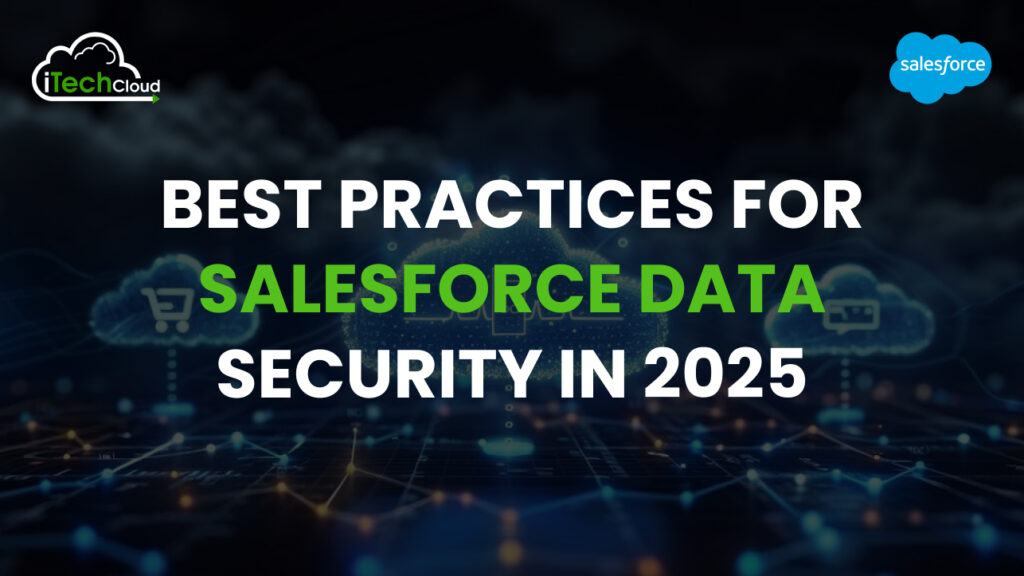Best Practices for Salesforce Data Security in 2025

Salesforce remains the leading CRM platform, empowering businesses with robust customer relationship management tools. However, as cyber threats evolve, ensuring data security in Salesforce is more crucial than ever. In 2025, organizations must adopt a proactive approach to safeguard sensitive data, maintain regulatory compliance, and prevent unauthorized access.
Here are the best practices for Salesforce data security in 2025.
Table of Contents
1. Implement Multi-Factor Authentication (MFA).
Multi-Factor Authentication (MFA) adds an additional layer of security beyond just usernames and passwords. As phishing and credential-stuffing attacks increase, Salesforce mandates MFA for all logins to prevent unauthorized access. Organizations should:
- Require MFA for all users accessing Salesforce.
- Use secure authentication methods such as biometric authentication or time-based one-time passwords (TOTP).
- Implement Single Sign-On (SSO) with MFA for streamlined security management.
2. Strong Password Policies
Weak passwords are a primary cause of data breaches. To enhance password security:
- Enforce complex passwords (e.g., a mix of uppercase, lowercase, numbers, and symbols).
- Require periodic password changes.
- Prevent users from reusing old passwords.
- Use password managers to store credentials securely.
3. Utilize Role-Based Access Control (RBAC)
Salesforce allows administrators to assign roles and profiles to users based on job responsibilities. Implementing RBAC ensures that users have access only to the necessary data, minimizing exposure to sensitive information. Best practices include:
- Assigning the least privilege access required for job functions.
- Regularly reviewing and updating user roles.
- Implementing field-level and object-level security.
- Monitoring for excessive permissions and adjusting accordingly.
4. Enable Data Encryption
Data encryption protects sensitive information from unauthorized access, ensuring compliance with industry regulations like GDPR, CCPA, and HIPAA. Salesforce offers encryption features such as:
- Shield Platform Encryption: Encrypts data at rest without affecting functionality.
- Transport Layer Security (TLS): Ensures secure data transmission.
- Encryption Key Management: Helps in managing encryption keys securely.
5. Regular Security Audits and Monitoring
Conducting regular security audits helps identify vulnerabilities and prevent potential threats. Organizations should:
- Perform routine security assessments and penetration testing.
- Use Salesforce Health Check to evaluate security settings.
- Enable Field Audit Trail to track changes in critical records.
- Monitor security logs for suspicious activities.
6. Implement IP Whitelisting and Login Restrictions
Limiting access to Salesforce only from trusted networks reduces the risk of unauthorized logins. Implement the following:
- Restrict login access based on IP ranges.
- Set login hours to prevent after-hours access.
- Use location-based access control to block logins from untrusted regions.
7. Secure API and Integration Endpoints
Salesforce integrates with various third-party applications via APIs, increasing the risk of security breaches. To protect API endpoints:
- Use OAuth 2.0 for secure authentication.
- Implement API rate limiting to prevent abuse.
- Regularly review and audit API access permissions.
- Disable unused API endpoints to reduce attack surfaces.
8. Data Backup and Disaster Recovery Plan
Data loss can have catastrophic consequences. Organizations should:
- Regularly back up Salesforce data using native and third-party solutions.
- Store backups in encrypted and secure locations.
- Establish a disaster recovery plan with defined recovery objectives.
- Test recovery procedures periodically to ensure reliability.
9. Enable Event Monitoring and Threat Detection
Salesforce provides Event Monitoring to track user activities, which helps detect and prevent security threats. Key features include:
- Monitoring login attempts, report exports, and record modifications.
- Identifying unusual data access patterns.
- Integrating with SIEM (Security Information and Event Management) tools for real-time threat detection.
- Setting up alerts for suspicious activities.
10. Implement Data Masking and Redaction
Protecting sensitive data from exposure, especially in sandbox environments, is critical. Implement:
- Salesforce Shield Data Masking to obfuscate data.
- Redaction techniques to hide sensitive information.
- Controlled access to personally identifiable information (PII) and financial data.
11. Stay Compliant with Regulatory Standards
Salesforce users must comply with industry regulations, including:
- GDPR (General Data Protection Regulation) for European users.
- CCPA (California Consumer Privacy Act) for California-based customers.
- HIPAA (Health Insurance Portability and Accountability Act) for healthcare organizations.
- SOC 2 Compliance for service organizations handling customer data.
To ensure compliance:
- Conduct regular audits.
- Implement data classification to categorize and protect sensitive data.
- Define and enforce data retention policies to manage the data lifecycle.
12. Educate Employees on Security Best Practices
Human error is one of the leading causes of data breaches, so organizations should:
- Conduct regular security training for employees.
- Educate staff on phishing attacks and social engineering tactics.
- Establish security awareness programs with simulated phishing exercises.
- Encourage a culture of cybersecurity vigilance.
13. Review and Manage Third-Party Applications
Third-party applications in Salesforce AppExchange can enhance functionality but also introduce security risks. To mitigate risks:
- Vet applications before installation.
- Review security policies and permissions of third-party apps.
- Conduct regular app security assessments.
- Remove unused or outdated applications.
14. Automate Security Processes
Automation improves security management efficiency. Organizations can:
- Use Salesforce Flow to automate security-related workflows.
- Implement automated security alerts and incident response.
- Leverage AI-driven anomaly detection for proactive security measures.
15. Maintain a Proactive Incident Response Plan
Despite all security measures, breaches can still occur. A well-defined Incident Response Plan (IRP) is essential:
- Establish a dedicated security response team.
- Define clear incident response protocols.
- Conduct regular security drills and simulations.
- Maintain open communication channels for security alerts.
Conclusion
Salesforce data security in 2025 demands a proactive and multi-layered approach. By implementing best practices such as MFA enforcement, strong access controls, encryption, security monitoring, compliance adherence, and employee training, organizations can effectively mitigate risks and protect their critical data assets. As cyber threats evolve, staying vigilant and continuously updating security measures will be key to maintaining a secure Salesforce environment.

